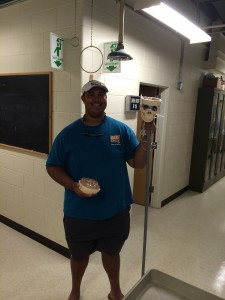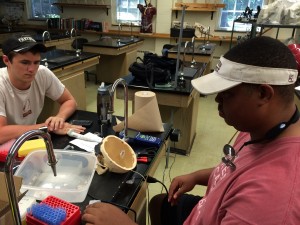Harold Willis ’16
This summer I am researching head and helmet impacts that can cause concussions in American Football (Football). Through a series of experiments I will obtain data on the intensity and location of head impacts an Offensive Lineman and Defensive Lineman may suffer. Once the analysis of the data is completed, I will be able to conclude which areas of an Offensive and Defensive lineman’s brain are most susceptible to trauma. Through the data I will monitor the frequency and intensity of impact on the areas of the brain that are most susceptible and then utilize that information to focus on protection for the areas of the brain affected. To obtain this data an accelerometer is enclosed inside a ballistic gel brain model and is used to collect the data needed for my study. This model gives me the ability to measure the intensity of the impact not only on the skull, but also on the brain. A drop test was conducted on a grass field from the average height of an offensive lineman (6’4”), and a defensive lineman (6’2”), in order to collect the intensity of impact through the accelerometers inside the brain. Once the data was collected, I placed the skull model on a variety of different helmets and ran the same experiment. This data will reveal which helmet type is best to protect the brain. From this data I will understand the susceptible areas of the brain. Later on, I hope to create a prototype for a helmet that protects Offensive and Defensive lineman from concussion brain trauma. As a college football player I am learning ways to extend my career in football and understanding how to protect football players from sport related injuries. I believe my research will impact the game of football and contribute to the protection other athletes can establish for themselves to prevent a possible concussion. I am passionate about the sport of football and envision these results helping me build a career in injury prevention. I foresee extending my focus of injury prevention to creating a helmet that protects all positions on the football field and then move to working on protection for other types of injuries that a football player or other types of athletes may sustain during their career.
Kyle Deivert ’16
This summer I have been researching head/helmet impacts in wide receivers and running backs. I have obtained data of intensity and location of head impacts for wide receivers (WRs) and running backs (RBs). After analysis of the data I have come to a conclusion of which areas of the brain are most vulnerable for each position: back, front, or side. The frequency and intensity of impacts to the specific areas of the head will determine the amount of focus on that area as far as methods of protection. After obtaining and analyzing this data I have set up the head/helmet testing. To obtain data for testing I have used accelerometers to measure intensity of impact and a synthesized ballistic gel to represent the brain in a skull model. Later in my research I hope to compare the effects of impact on different locations of an assortment of helmet brands to determine which helmets protect which areas of the brain more effectively. I have preformed dropped tests from an averaged height of 6 feet onto a grass field and collected data with the accelerometers inside the brains. I hope, at some point, to be able to move on to the design and construct new helmets for both RBs and WRs based on their more vulnerable locations of impact. As a collegiate football player I am very passionate about the sport and I am determined to achieve the best, most significant results. I hope to gather enough data to continue in the field of injury prevention and quite possible change the layout and construction of football helmets so players from youth to professional levels can play the game they love with less worry of receiving traumatic head injuries.


